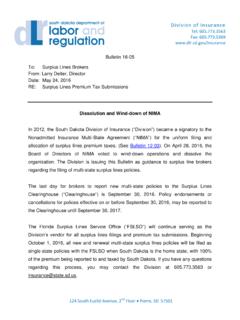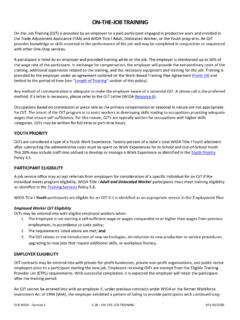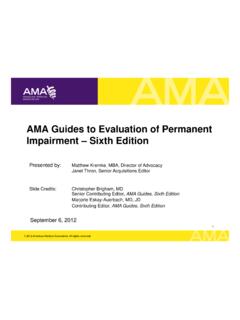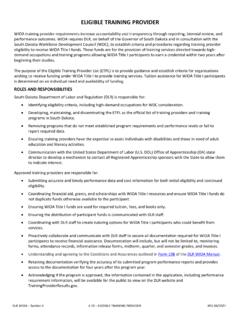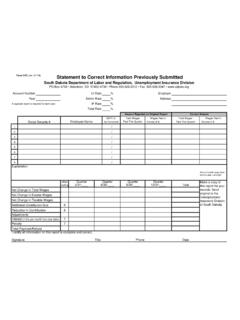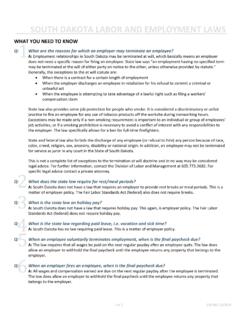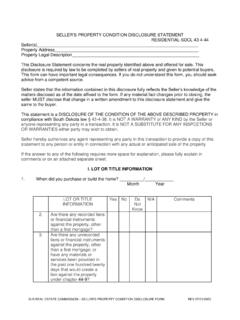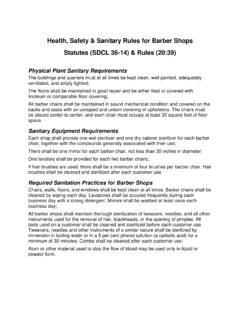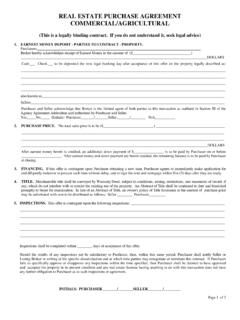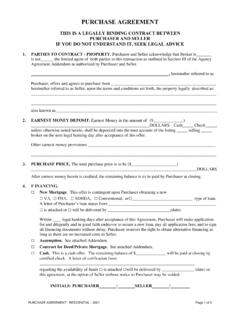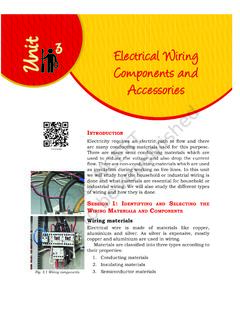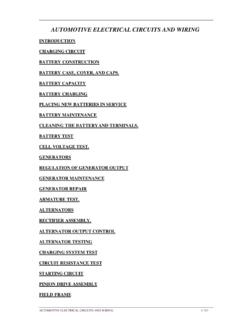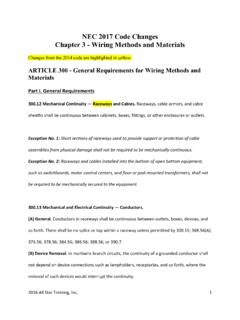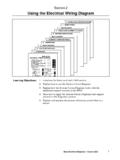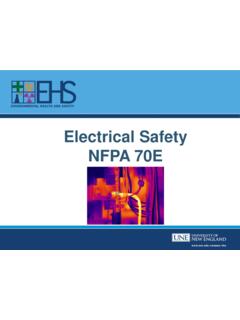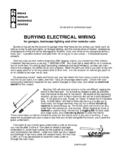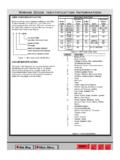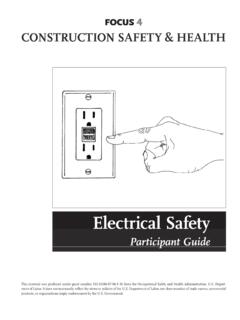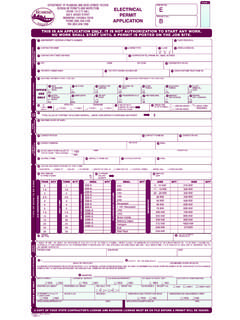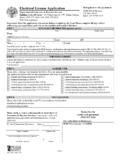Transcription of HOMEOWNER WIRING MANUAL - South Dakota
1 REV 09/2020 South Dakota electrical COMMISSION 308 S. Pierre St., Pierre, SD 57501 Tel: | Toll-Free: HOMEOWNER WIRING MANUAL TABLE OF CONTENTS Residential electrical Inspections .. 2 electrical 3 General 4 Ground Fault 6 Arc-Fault Circuit-Interrupter Protection .. 6 WIRING 6-8 Equipment Listing and Labeling .. 8 electrical 8-9 Grounding .. 9-10 Underground WIRING .. 10 2 of 10 HOMEOWNER WIRING South Dakota allows homeowners to install electrical WIRING under what is known as the HOMEOWNER exemption. Statute 36-16-15 states in part, that no license is required of an individual installing electrical WIRING in his own residence or farmstead. Chapter 20:44:14:01 (12) Owners Exemption states an exemption from licensure requirements for an individual owner who is PERSONALLY installing electric WIRING and fixtures in a residence or farmstead which is owned and resided in or on by the person installing the electrical WIRING or fixtures.
2 This exemption does not allow licensed electricians or electrical contractors or any other person to do work under a HOMEOWNER WIRING permit nor does it allow for homeowners to do work under a contractors WIRING permit. A HOMEOWNER WIRING permit may not be used to install WIRING for mobile homes on rented lots or in mobile home parks, rental property or property for commercial use. RESIDENTIAL electrical INSPECTION All electrical installations must meet the National electrical Code and the requirements of the South Dakota State Laws and Rules. The standard for compliance with the national electrical code is universal. The National electrical Code is updated every three years, as is the South Dakota State WIRING Bulletin. Please note additional consultation and/or inspections over and above the typical inspection process will be charged an addition fee per SD Administrative Rule 20:44:19:07(4).
3 Any installer must provide at least 72 hour notification to the inspector or the Commission office for an inspection. You are required to notify your local inspector and have a rough-in inspection completed prior to insulating, sheet rocking, paneling or covering the installation with any other type of material which would inhibit the rough-in inspection. Underground WIRING must be inspected before the trench is back-filled. A final inspection is required for all jobs prior to occupancy. All WIRING permits are good for three years, if the job is not completed by the end of three years you will need to purchase another WIRING permit to complete the job. Failure to do so could result in a $100 administrative fee. Please be cautious if you are not certain as to the requirements of a South Dakota electrical installation. It is the installer s responsibility to understand the laws and rules which govern installations.
4 Utilize a licensed electrical contractor as a consultant or an installer to mitigate costly expenses due to nonprofessional advice, noncompliant materials or poor installation techniques. If you need further assistance, please call the electrical Commission office at YOU ARE REQUIRED TO CONTACT YOUR INSPECTOR FOR INSPECTIONSAn electronic version of the HOMEOWNER WIRING MANUAL can be found at: 3 of 10 electrical INSPECTORS Any installer must provide at least 72 hour notification to the commission office when an electrical job is at a rough-in stage requiring inspection to assure compliance with the National electrical Code, a stage of correcting or completing items on a report, or prior to occupancy for final inspection. District 1 Presho District 2 St. Francis District 3 Brookings District 4 Mitchell District 5 Hartford District 6 Aberdeen District 7 Whitewood District 8 Platte District 9 Brent Schoulte Stan Rogers Kyle Dahl Vacant Jason Wingert Dan Larson VacantThad Stoddard Vacant Centerville District 10 Bob Jaskulka Watertown District 11 Scott Ochsner Tea District 12 Dan Schoenfelder Scotland District 13 Aaron Dimitt Sturgis District 14 Jeff Hotchkiss Mobridge District 17 Tom Kelly Aberdeen District 21 Doug Viet Sioux Falls District 22 Curt Mitchell Sinai District 24 Tim Heariet Spearfish To view a current list of inspectors: To calculate inspection fees: 4 of 10 PLAN YOUR WIRING PROJECT This brochure is intended to be a general overview of residential electrical requirements.
5 No claim is made that this information is complete or beyond question. Additional information and knowledge is needed to properly install electrical WIRING that is essentially free from fire and electric shock hazard. Ultimately it is the installers responsibility to implement the most current code and requirements as adopted by the South Dakota electrical commission. For assistance, please reference authoritative publications based on the 2014 National electrical Code (the NEC). GENERAL CIRCUITRY Except for the final connection to switches, receptacles and lighting fixtures, all ground wires and other wire in boxes must be spliced and pigtailed for the rough-in inspection. The inspector will check, yet is not limited to, proper spacing of boxes, fastening of conductors, routing of conductors, conductor size, box size, box fill and general WIRING practices. NEC & in addition to the branch circuits installed to supply general illumination and receptacle outlets in dwelling units, the following minimum requirements apply: One 20-amp circuit for the bathroom receptacles One separate, individual branch circuit for central heating equipmentNEC All conductors of the same circuit, including grounding and bonding conductors, shall be contained in the same raceway, cable or trench.
6 NEC Every circuit and circuit modification shall be legibly identified as to its clear, evident and specific purpose or use in sufficient detail on a directory located on the face or inside of the electrical panel doors. Example: Upstairs northwest bedroom (NOT KIDS BEDROOM). NEC Generally, the rating of the fuse or circuit breaker determines the minimum size of the circuit conductor, per the following table: Fuse or Circuit Breaker Size Minimum Wire Size Copper Conductor Aluminum Conductor 15 amp 14 n/a 20 amp 12 n/a 30 amp 10 8 40 amp 8 6 50 amp 6 4 NOTE: Conductors that supply motors, air-conditioning units, and other special equipment may have overcurrent protection that exceeds the general information in the above chart. NEC Receptacle outlets shall be of the grounding type, be effectively grounded, and have proper polarity. NEC NEC requires all receptacles in dwelling units to be tamper-resistant as listed in , this includes garages and accessory buildings (attached and detached).
7 NEC (A) Receptacles shall be installed in rooms so that n o point measured h orizontally along the floor line of any wall i s more than 6 f eet f rom a r eceptacle o utlet (no more than 12 f eet between o utlets). Any wall space 2 feet or more in width shall have an outlet. 5 of 10 NEC (B) At least two separate small appliance branch circuits are required for kitchen countertop receptacles. These outlets shall be GFCI protected. The dishwasher and garbage disposal are not permitted on these circuits and must have their own circuit. NEC (C) At kitchen countertops receptacle outlets shall be installed so that no point along the wall line is more than 24 inches measured horizontally from a receptacle outlet in that space. Countertop spaces separated by range tops, sinks, or refrigerators are separate spaces.
8 A receptacle outlet shall be installed at each wall countertop that is 12 inches or wider and at each island or peninsula space 24 inches by 12 inches or greater. Receptacles shall be located not more than 20 inches above the countertop, or mounted below a countertop less than 6 inches beyond the support base, not more than 12 inches below the countertop. NEC (C) At least one 20 amp receptacle outlet shall be installed for the laundry. SDAR 22:44:22:23 Dwelling unit receptacle outlets Countertops and peninsulas. Island and peninsular countertops in dwellings units are exempt from the National electrical Code requirements. NEC (E) At least one receptacle outlet accessible while standing at grade level and located not more than 6 and one half feet above grade level shall be installed at the front and back of the dwelling. At least one receptacle outlet shall be installed on any balcony, deck, or porch that is accessible from inside the dwelling.
9 These receptacles shall be listed as WR and shall have covers that are weatherproof whether or not an attachment plug is inserted. NEC (H) At least one receptacle outlet shall be installed in any hallway that is 10 feet or more in length. NEC (I) Foyers that have an area that is greater than 60 square feet shall have a receptacle outlet located in each wall space 3 feet or more in width and unbroken by doorways, floor to ceiling windows and similar openings. NEC (G) At least one receptacle outlet must be installed for each car space in the garage, this circuit shall not supply outlets outside of the garage. NEC a 15- or 20-amp 125 volt weatherproof GFCI protected outlet shall be installed within 25 feet of the outside air conditioning unit. This is required for servicing the unit. NEC At least one wall-switched controlled light shall be installed in every habitable room, hallway, stairway, attached and detached garages and outdoor entrances.
10 Where a light is installed in a stairway, it shall be switched at each level. For attics, crawl spaces, utility rooms, and basements at least one light containing a switch or controlled by a wall switch shall be installed. NEC Electric ranges require a 40 amp 120/240 volt 4-wire circuit and a 4-wire receptacle. Electric dryers require a 30 amp volt circuit and a 4-wire receptacle. NEC Where lights are controlled by switches there shall be a grounded conductor or neutral for the circuit at each switch box. NEC (B) Electric water heaters usually require a 30 amp 240 volt 3-wire circuit. If it is not in sight of the electrical service, it must have a disconnecting means at the water heater. A receptacle and cord is not acceptable. NEC An intersystem bonding termination shall be provided at the service equipment for the purpose of bonding communications systems such as cable TVs and phones.
